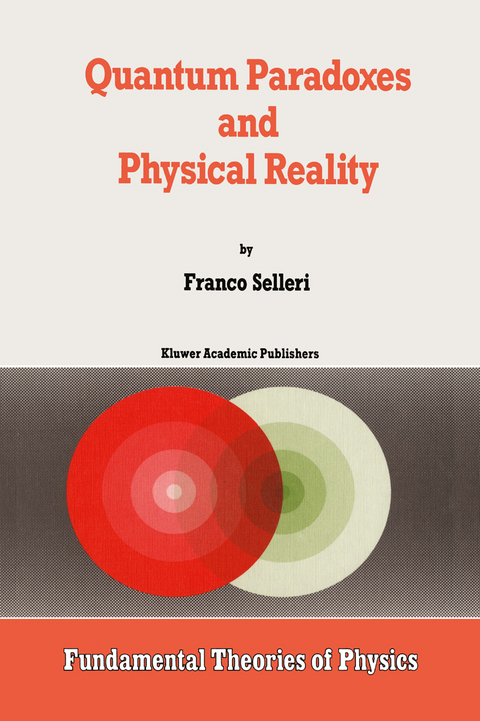
Quantum Paradoxes and Physical Reality
Springer (Verlag)
978-0-7923-0253-7 (ISBN)
1 / Quantum Theorists and the Physical World.- 1.1. Three Central Questions about Physics.- 1.2. The Older Generation.- 1.3. The Middle Generation.- 1.4. The Younger Generation.- 1.5. Conclusions.- 2 / Is Quantum Mechanics a Complete Theory?.- 2.1. The Problem of Completeness and of Hidden Variables.- 2.2. De Broglie’s Paradox.- 2.3. The Spin-1/2 System in Quantum Mechanics.- 2.4. A Simple Proof of von Neumann’s Theorem.- 2.5. The Theorem is not General Enough.- 2.6. Von Neumann’s Theorem: Assumptions, Definitions, and Results.- 2.7. General Proof of von Neumann’s Theorem.- 2.8. Jauch and Piron’s Theorem.- 2.9. The Debate on Impossibility Proofs.- 3 / The Wave—Particle Duality.- 3.1. Duality for Photons.- 3.2. Duality for Neutrons.- 3.3. Einstein’s Discovery of Duality.- 3.4. De Broglie’s Duality.- 3.5. Schrödinger’s Waves.- 3.6. Bohr’s Complementarity.- 3.7. Fock’s Relativity with Respect to the Means of Observation.- 3.8. Heisenberg Beyond Complementarity.- 3.9. The Consciousness Interpretation.- 3.10. Delayed Choices.- 3.11. How to do what Complementarity Forbids.- 4 / Properties of Quantum Waves.- 4.1. Quantum Waves and Quantum Potential.- 4.2. Experiments on the Nature of Duality.- 4.3. Stimulated Emission.- 4.4. Quantitative Empty Wave Amplification.- 4.5. Two Further Experimental Proposals.- 4.6. Triple-Slit Experiments.- 4.7. The Bohm—Aharonov Effect.- 4.8. Further Ideas about Wave—Particle Duality.- 5 / The Einstein—Podolsky—Rosen Paradox.- 5.1. The Original Formulation.- 5.2. Bohr’s Answer.- 5.3. Two Types of State Vectors.- 5.4. Spin States for Two Particles.- 5.5. Reality and Separability.- 5.6. The EPR Paradox: Quantum Mechanics Complete.- 5.7. The EPR Paradox: Quantum Mechanics not Complete.- 5.8. From Theory to Practice.-5.9. The Experimental Information.- 5.10. Solution 1: Modifying the Past.- 5.11. Solution 2: Superluminal Connections.- 5.12. Solution 3: New Definitions of Probability.- 5.13. Solution 4: Modifications of Quantum Theory.- 6 / The EPR Paradox in the Real World.- 6.1. Criticisms of Einstein Locality.- 6.2. Probabilistic Einstein Locality.- 6.3. New Proof of Bell’s Inequality.- 6.4. Probabilities for Pairs of Correlated Systems.- 6.5. A New Factorizability Condition.- 6.6. All the Inequalities of Einstein Locality.- 6.7. Tests of the EPR Paradox in Particle Physics.- 6.8. On the Possibility of New Experiments.- 6.9. Variable Probabilities.- 7 / Perspectives of Physical Realism.- 7.1. Objectivity of Scientific Knowledge.- 7.2. Mathematics and Reality.- 7.3. The Role of History of Physics.- 7.4. Fragmentation of Modern Physics.- 7.5. Niels Bohr and Philosophy.- 7.6. Quantum Physics and Biological Sciences.- 7.7. Forms of Physical Realism.
| Erscheint lt. Verlag | 31.12.1989 |
|---|---|
| Reihe/Serie | Fundamental Theories of Physics ; 35 |
| Zusatzinfo | X, 374 p. |
| Verlagsort | Dordrecht |
| Sprache | englisch |
| Maße | 155 x 235 mm |
| Themenwelt | Naturwissenschaften ► Physik / Astronomie ► Astronomie / Astrophysik |
| Naturwissenschaften ► Physik / Astronomie ► Atom- / Kern- / Molekularphysik | |
| Naturwissenschaften ► Physik / Astronomie ► Quantenphysik | |
| Naturwissenschaften ► Physik / Astronomie ► Theoretische Physik | |
| ISBN-10 | 0-7923-0253-2 / 0792302532 |
| ISBN-13 | 978-0-7923-0253-7 / 9780792302537 |
| Zustand | Neuware |
| Haben Sie eine Frage zum Produkt? |
aus dem Bereich


